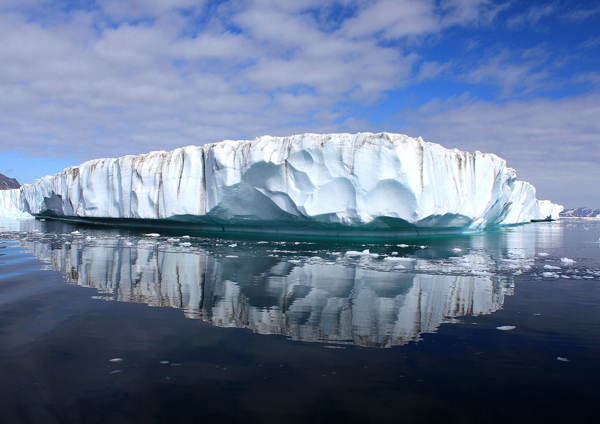Bad News: The Antarctic Ice Sheet Isn’t The Only One Melting

The Article: The Big, Scary News About Melting Antarctic Ice Is Just the Beginning by Emily Atkin in The New Republic.
The Text: Lots of people seemed shocked by Monday’s big news about climate change—that a huge mass of ice is melting in Antarctica, gradually raising sea levels and threatening low-lying communities around the world. They shouldn’t have been. And they should be prepared for more news just like it, because the South Pole isn’t the only part of the world where global warming is slowly but surely wreaking environmental havoc.
The news that got so much attention on Monday was about what’s officially known as the “West Antarctic Ice Sheet,” a 77 million cubic foot ice mass that sprawls across the portion of the continent in the western hemisphere and closer to South America. Unlike most ice sheets, its base is located below sea level, allowing for faster melt with the rush of warm ocean currents.
Because of this and other factors, scientists have been predicting instability in the glaciers of the West Antarctic Ice sheet since at least the 1960s, when Ohio State University glaciologist John Mercer cited the area as “uniquely vulnerable and unstable.” Eighteen years later, Mercer went even further, predicting that the melting was a result of higher carbon dioxide concentrations in the atmosphere—and that, left unchecked, the melting would cause sea levels to rise and reach catastrophic levels.
“I contend that a major disaster—a rapid 5-meter rise in sea level caused by deglaciation of West Antarctica—may be imminent or in progress after atmospheric CO2 content has only doubled,” he wrote in a 1978 paper published in Nature. “This concentration will be reached within about 50 years if fossil fuel continues to be consumed at its recent accelerating rate, or within about 200 years if consumption is held constant at today’s levels.” Follow-up work by other researchers all pointed to the same conclusion: that West Antarctic glaciers are rapidly melting. Just this past January, a study published in the journal Nature found that one of West Antarctica’s largest glaciers had entered an “irreversible” melt, with the potential to add one centimeter to ocean levels within the next 20 years.
The latest research, announced by scientists at NASA and published in two scientific journals, became public on Monday. It suggests that Mercer and the many scientists who came after him underestimated just how badly carbon dioxide could affect the ice sheet. Carbon dioxide levels have risen just 19 percent since 1978—from 337 parts per million then to just over 400 parts per million now. According to the new papers, even that (seemingly) modest increase is enough to unleash melting that could increase sea levels by four to 13 feet. Mercer had predicted it would take much, much more carbon in the atmosphere to produce that kind of melting and sea level changes.
That’s bad news for the planet. In places like Florida, Bangladesh, and other low-lying areas, even modest increases in sea levels—the kind possible before the beginning of the next century—would have dire, civilization-changing consequences. Worse still, the Antarctic glaciers aren’t the only ones melting. Yes, that’s right: Monday’s news may be a preview of similar stories to come.
Among scientists, the ice sheet that gets the most attention after Antarctica’s is probably one all the way on the other end of the world. It’s the Greenland Ice Sheet, which covers about 80 percent of the massive country. Its glaciers also contain billions of gallons of freshwater, meaning a rapid melt could mess with the salinity of the ocean. Since our salty ocean absorbs much of the carbon dioxide we pump into the air, that’s not the best scenario for global warming.
Though it’s not definitively known how badly the Greenland Ice sheet is melting, Ohio State polar researcher Jason Box predicted in 2012 that the mass is approaching a dangerous “tipping point” that could also have “huge implications” for global sea levels and ocean carbon dioxide absorption.
Greenland’s ice is melting for the same reason that Antarctica’s is: Warming ocean and atmospheric temperatures. The last U.N. Intergovernmental Panel on Climate Change report to address this was back in 2007, predicting sea level rise of between 0.6 and 1.9 feet from the melting ice giant by 2100. But the report acknowledged that it did not include “an upper bound for sea level rise”—that oceans could rise by even greater amounts.
Scientists are now attempting to come up with that upper bound, but are finding it difficult. Even though researchers have seen ice loss almost double in the last decade, they are having trouble finding conclusive data—and remain unsure whether the ice loss is temporary or permanent. “Greenland is very complex and it’s very, very difficult to predict what will happen in the future,” Shfaqat Abbas Khan, a climate scientist at the National Space Institute at the Technical University of Denmark, told Livescience in March. “This also means our future estimates of sea level rise are also difficult to predict.” But a complete melting of the Greenland Ice Sheet would contribute to sea level rise by more than seven meters, or a whopping 23 feet. That means even a partial melting would have catastrophic effects.









